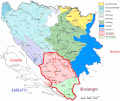Vrelo Bosne
| Vrelo Bosne | |
|---|---|
| Spomenik prirode Vrelo Bosne | |
 A bridge near the spring of the Bosna river | |
| Location | Sarajevo Canton, Bosnia and Herzegovina |
| Nearest city | Sarajevo |
| Coordinates | 43°49′08″N 18°16′10″E / 43.818867°N 18.269447°E |
| Area | 6.03 km2 (2.33 sq mi)[1] |
| Average elevation | 520 m (1,710 ft);[2] (494.5 m (1,622 ft) a.s.l. according to an earlier source[3]) |
| Established | 1995 |
| Visitors | Open all year (in Open all year) |
| Operator | Kantonalna javna ustanova za zaštićena prirodna područja – ZPPKS |
| Website | www |
 | |
Vrelo Bosne (pronounced [ʋrê.lo bôs.neː]; transl. Spring of the Bosna) is a public park and a protected Nature Monument established around the source of the Bosna river, featuring the system of numerous springs at the foothills of Mount Igman, in the municipality of Ilidža, on the outskirts of Sarajevo, capital of Bosnia and Herzegovina. Vrelo Bosne is one of the country's popular natural landmarks and provides a quiet escape from city life.
Geography and hydrology
[edit]
The Mala Bosna is the first section of the Bosna, and its source is the Vrelo Bosne spring, located at 520 m (1,710 ft) a.s.l.[2] (according to an earlier source, 494.5 m (1,622 ft) a.s.l.[3]) at the foothills of mount Igman, on the outskirts of Sarajevo, capital of Bosnia and Herzegovina.[2] The spring is one of Bosnia and Herzegovina's chief natural landmarks and tourist attractions.[4]
Biodiversity
[edit]Typical animals are ducks and swans among others.[5]
History, archaeology and culture
[edit]A Roman Bridge is located not far from Vrelo Bosne on the Bosna river in the Ilidža municipality, which was built sometime between 1530 and 1550 from the original Roman stones and ruins of the bridge that stood there during the Roman period used to connect the Romans with the village of Aquae Sulphurae at the time. Ilidža is also known to have been an archaeological site dating 2400–2000BC.[6]
The straight main avenue (Velika Aleja) leading inside contains traditional buildings from the Austro-Hungarian-era offering a peek into the luxuries of the past.
During the Bosnian War the park was not maintained and trees were chopped and used for heating by the local citizens. In 2000 the park was restored to its former look by local youths led by an international ecological organization.[citation needed]
Park entry and features
[edit]On a typical year more than 60,000 tourists visit the park.[7]
The park is usually entered by foot or by horse-carriage via the 3 kilometre long avenue Velika Aleja (transl. Grand Avenue) leading from the hotel complex and a spa at the northeastern end, called Banja Ilidža, toward springs at the far southwestern end. There is also Mala Aleja (transl. Little Alley) which branches off towards Stojčevac to the southeast.
The paths and roads inside the park are ideal for walks and bicycle riding[8] and give the visitors the opportunity to take a closer look at the bubbling streams and waterfalls. Outdoor cafés and restaurants are available offering drinks and food but opening times vary from season to season.
- Adults: 2 KM
- Pensioners, students, disabled: 1 KM
- Children from 7–16 years old: 1 KM
- Children with special needs or up to 7 years old: Entry free
Money from the park entry fees is used to up-keep the park by KJU Zaštićena prirodna područja Kantona Sarajevo.[9]
The spring water at Vrelo Bosne is drinkable, however not recommended.[10]
Photo gallery
[edit]-
Spring of the River Bosna, Sarajevo (Autumn 2005)
-
Spring of the River Bosna, Sarajevo
-
Horse carriage (Velika aleja)
-
Vrelo Bosne Bridge
-
Vrelo Bosne Park
-
Vrelo Bosne (Summer 2010)
-
River Bosna at Vrelo Bosne
-
River Bosna, Sarajevo (Autumn 2005)
-
Vrelo Bosne (Summer 2010)
-
Vrelo Bosne ducks
-
Vrelo Bosne ducks
-
Ducks at Vrelo Bosne
-
Ducks at Vrelo Bosne
-
Baby duck at Vrelo Bosne
-
Vrelo Bosne Swans
-
Vrelo Bosne Swans
-
Vrelo Bosne Swans
-
Vrelo Bosne Swans
-
Vrelo Bosne in winter
Trivia
[edit]Bosnia and Herzegovina national football team is known to hold their training sessions at the Vrelo Bosne park.[11] Team also stays at near by Hotel Hercegovina.
See also
[edit]References
[edit]- ^ Vrelo Bosne Protected Planet
- ^ a b c PLAN UPRAVLJANJA SPOMENIKOM PRIRODE VRELO BOSNE 2020-2030 (PDF). p. 25. Retrieved 14 November 2023.
- ^ a b Aganović M. (1965). "Komparativna istraživanja režima ishrane, rasta, plodnosti i strukture populacija lipljena u rijekama Bosni i Plivi". Godišnjak - The Annual of the Institute of Biology. 18. Institute of Biology - PMF University of Sarajevo: 5. Retrieved 14 November 2023.
- ^ PLAN UPRAVLJANJA SPOMENIKOM PRIRODE VRELO BOSNE 2020-2030 (PDF). pp. 9–53. Retrieved 14 November 2023.
- ^ "Snimak iz zraka: Ovako pod snijegom izgledaju Vrelo Bosne i Rimski most". klix.ba. Retrieved 8 March 2015.
- ^ "Sarajevo grad bogate historije". hamdocamo.wordpress.com. Retrieved 31 January 2013.
- ^ "Vrelo Bosne od početka godine posjetilo 60.000 turista". klix.ba. Retrieved 17 July 2014.
- ^ "Sutra biciklijada na Vrelu Bosne". klix.ba. Retrieved 4 June 2013.
- ^ "Naplaćivanje ulaznica na Vrelo Bosne donosi rezultate: Skupljen novac za početno fijakersko stajalište". oslobodjenje.ba. Retrieved 22 September 2013.
- ^ "Voda na Vrelu Bosne je pogodna za piće!". klix.ba. Retrieved 1 August 2013.
- ^ "Zmajevi trenirali na prelijepom Vrelu Bosne". reprezentacija.ba. Retrieved 4 June 2015.






















